With a renewed push from the Obama administration to impose new, more restrictive gun control legislation following yet another poorly reported on shooting, this time at the Washington Navy Yard in Washington DC, American’s are in for another round of devastating blows to their second amendment rights. Gun owners and second amendment rights advocates across the nation know that it is not a matter of if but a matter of when, and many are scrambling to buy up as many of the items that are in the cross-hairs of Diane Feinstein and the Obama administration as they possibly can while they are still available to civilians.
In light of recent events, I thought now a better time than ever to examine the firearms that will undoubtedly soon be banned, and put together a buyer’s guide of sorts with my views and opinions about the best firearms to purchase in preparation for a doomsday scenario before a ban is put into action. Each of the items listed has its own merits, strengths, and weaknesses. I will go in depth about the pros and cons of each, and do my best to mitigate risk of any first time buyer mistakes (some drawn from my own personal experience).
AR-15
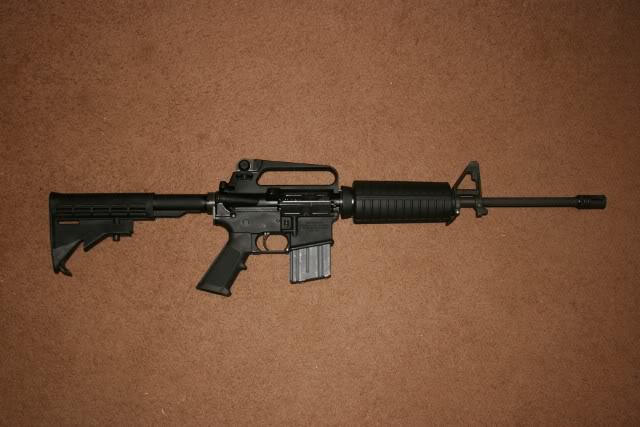
The AR15 is one of the most widely produced rifles in America, largely due to its highly customizable, versatile, and user friendly design that allows shooters to tailor their rifle to their liking with ease. The AR15 operates on a direct impingement gas system, and is commonly chambered in 5.56/.223. The AR15 platform is the base of the military rifles M16 and the shorter M4A1, and is the most widely used combat rifle by US soldiers and special operations law enforcement. One of the most common mistakes made by first time buyers is thinking that all AR’s are the same thing with a different logo on the box, but there are definitely differences in quality and versatility which buyers should be mindful of when selecting which one(s) to spend their hard earn dollars on. High end rifles, like anything else of quality in this world, do not come cheap. You may be able to find a screaming deal on a particular make or model, but when you are talking about something you will have for the rest of your life; something you soon will never have the opportunity to purchase again and something you may trust your life to in a crisis scenario, going for the cheapest option is never a good idea (in my humble opinion). That said, let’s talk about what to look for. For a first time buyer who has little experience with the AR platform, it can be very easy to get lost in the weeds and stuck in the mindset that an AR is an AR. This was my problem when I purchased my first AR a few years ago. I didn’t really know what I wanted or what to look for, and I couldn’t really tell the difference between one of the $3k rifles and one of the $700 rifles on the wall. This was back in the days when you could actually get a complete mil-spec AR15 of relatively good quality for $700 at the local gun store. Now, prices have literally doubled, supply has decreased and demand has dramatically increased, and you can’t even get a high quality lower receiver for under $250. But I digress, let’s talk pros and cons of the AR15 platform.
Pros:
The AR15 platform has been around for a long time, and although there are newer 5.56 caliber military style rifles that have been introduced as an alternative to the AR15, none have been as widely tested and improved by military and law enforcement use than the AR15. Because they have been around for so long and have proven to be relatively dependable, the aftermarket parts that are available for mil-spec AR15 rifles outnumber any other of the proprietary AR15 offshoots such as the Bushmaster ACR or SCAR 16. Basically, the classic AR15 design has time on its side. Ammunition availability is something else you need to consider, especially if you are preparing for a doomsday scenario. The classic AR15 is chambered in the battle tested 5.56 NATO caliber which has been in use by US military and special law enforcement for decades. Not only does the AR15 use the popular 5.56 NATO round, but it is capable of firing several other calibers by swapping out the upper receiver. What this means is that in theory, you could purchase an AR15 chambered in 5.56 NATO, and purchase a couple complete barreled upper receivers in different calibers such as 300 Blackout and .458 SOCOM and have the ability to change your AR15’s caliber in a matter of minutes with no gunsmithing required. This gives you the option of having even more versatility than you would already have with a classic AR15 platform. Due to the small caliber and high velocity of the 5.56 round, rapid fire is very easy while staying on target.
Cons:
Some of the strengths of this rifle are negated by its weaknesses. Stopping power is one area where the AR15 leaves something to be desired. The 5.56 NATO caliber offers high velocity and little recoil, but since it is essentially a necked out .22, it lacks the stopping power of a bigger round such as a .308. The smaller, high velocity 5.56 NATO round allows for rapid fire without compromising accuracy due to high recoil and muzzle climb as with larger calibers. It also allows you carry more rounds without weighing you down, which can be a bigger deal than you might think if you are running around with a rifle slung on your shoulder. You will also notice that the 5.56 caliber rounds cannot penetrate through certain objects that a target may be located behind the way higher caliber rounds can. Depending on what you are preparing for, this may be something to consider when making the decision what to buy first. 5.56 NATO is definitely not a round designed for bear hunting, but still can be extremely effective due to the way the round “tumbles” after penetrating its target. Cost can be another drawback for a high quality AR15. You aren’t going to find anything of quality for under $1,000 in this political climate, and that is just for a barebones model with none of the bells and whistles. It is an investment that will not depreciate however, so keep that in mind when you are shopping.
AK47
The AK47 is another battle tested rifle that has been around for several decades. Its simple design 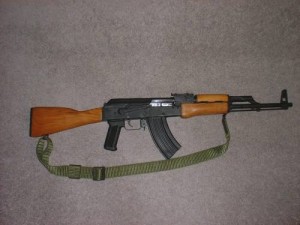 makes it extremely reliable, known worldwide for its durability and effectiveness at close to medium range. It is by no means a tack driver, but it was not designed to be one either. Its rugged minimalistic design is what has kept it in use for so many years without being replaced by more advanced small arms technology. There have been improvements made to the AK platform by the Izhmash factory in Russia where the Russian military and police force’s weapons are made, but those improvements have also driven up the cost. The classic AK47 platform operates on a gas piston system and are chambered in 7.62×39 caliber. They are known for being dirty and difficult to keep clean, mainly due to the gas piston system by which they operate. They are also known for having extremely noticeable muzzle climb, which significantly impacts accuracy especially when firing multiple shots in rapid succession. Although they are not known for their accuracy, there is no denying that the classic 7.62×39 AK round gets the job done. There is an old saying that goes something like “An AR15 is like a prom queen, she’s sexy and will do what you want if you treat her well. An AK47 is like a biker chick; she’s not that pretty, but she will get the job done every time you pick her up no matter how you treat her.” I think that’s a great (and colorful) way to describe the AK47 and compare it to the AR15.
makes it extremely reliable, known worldwide for its durability and effectiveness at close to medium range. It is by no means a tack driver, but it was not designed to be one either. Its rugged minimalistic design is what has kept it in use for so many years without being replaced by more advanced small arms technology. There have been improvements made to the AK platform by the Izhmash factory in Russia where the Russian military and police force’s weapons are made, but those improvements have also driven up the cost. The classic AK47 platform operates on a gas piston system and are chambered in 7.62×39 caliber. They are known for being dirty and difficult to keep clean, mainly due to the gas piston system by which they operate. They are also known for having extremely noticeable muzzle climb, which significantly impacts accuracy especially when firing multiple shots in rapid succession. Although they are not known for their accuracy, there is no denying that the classic 7.62×39 AK round gets the job done. There is an old saying that goes something like “An AR15 is like a prom queen, she’s sexy and will do what you want if you treat her well. An AK47 is like a biker chick; she’s not that pretty, but she will get the job done every time you pick her up no matter how you treat her.” I think that’s a great (and colorful) way to describe the AK47 and compare it to the AR15.
Because of its simplicity, you know that it is going to shoot every time you pick it up and pull the trigger. It is not susceptible to the same kind of issues that cause malfunctions in the field as an AR15, however by that same token, it is nowhere near as accurate (or as sexy). You have to be a bit more careful when shopping for an AK than you need to be when shopping for an AR platform rifle. There are a lot of low quality AK’s on the market that are poorly made, most from Romania, and some from poorly put together build kits form other parts of the world. The Romanian WASR 10 is notorious for being a low quality rifle that will likely give you more problems than its worth. These WASR 10’s and the slightly improved WASR 10/63’s are known for lacking the dimple in the receiver and having a lot of magazine wobble, canted sights, and poorly machined, rough internals which are prone to sticking. Some people swear that WASR’s don’t deserve their bad reputation and love their WASR 10, but in my opinion those bad reputations were hard earned and nobody who wants a quality firearm should purchase one of them. The Arsenal/Saiga AK47’s however are excellent and have redeemed the AK platform among gun collectors and AK enthusiasts. The receivers are double the thickness of a WASR, and that makes them significantly more accurate and reduces recoil. If you want a quality AK, a Saiga is the way to go. Saiga’s (also known as Arsenal AK’s) are genuine Russian AK47’s made in the Russian Izhmash factory that supplies their military and law enforcement. Having owned both, I can tell you with absolute certainty that they are the real deal, and they are the best AK’s on the market. I would recommend staying away from any rifle with WASR in the name.
 Pros:
Pros:
A battle tested 30 caliber round that is relatively inexpensive and easy to locate. These Kalashnikov style weapons are used all over the world, so finding ammunition in a crisis scenario shouldn’t be very difficult. AK47 rifles are extremely durable and can be thrown in water, sand, dirt, mud, and face extreme weather conditions without failing or having any functionality issues. This is one of the most, if not the most durable rifle you can buy. Pair that with the stopping power of the 7.62×39 caliber round and you have a true battle rifle. Cost of a high quality Saiga AK47 is higher than you would see one of the lower quality WASR 10’s priced at, but even the top of the line Saiga’s are reasonably priced considering what you are getting. Like the AR15, these rifles have time on their side, and there are many aftermarket parts available to customize your weapon to your liking. Also, because they utilize a gas piston system, there is no need for a buffer tube. This means if you are so inclined, you can modify your rifle to have an under-folding or side-folding stock, or no stock at all. They are relatively lightweight as well, which comes in handy if you plan on using high capacity steel surplus magazines.
Cons:
Unfortunately, there are a lot of cons for this particular item. One of the biggest is range and accuracy. There is a lot of debate about accuracy from AK enthusiasts, but in my experience it is not a very accurate rifle. The higher quality Saiga AK’s have improved range and accuracy due to the lessened recoil which is made possible by the thicker receiver (2mm vs the WASR 10 at 1mm), but they still kick like a mule and it is hard to keep on target when firing multiple shots in rapid succession. Another issue that is common with AK’s is the greasy buildup in the internals that seems almost impossible to get clean. If you have ever tried to clean an AK you know what I am talking about. While this can be lessened by using high quality ammunition, it is still an AK and it was basically designed to run dirty. Some people dislike the “rock and lock” motion that is required to insert a magazine into the gun as well. It isn’t a straight forward push to lock the magazine in the mag well like you would have on an AR15, but rather a front to back rocking motion that takes some getting used to and can slow you down if you aren’t familiar with it.
Saiga 12 (also referred to as AK-12)
Here is another product of the Izhmash factory in Russia that I just couldn’t keep off of this list. It is 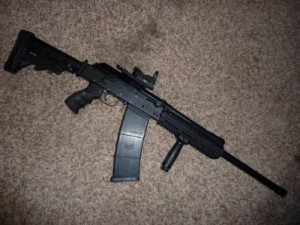 one of the most unique and powerful weapons available to civilians without a class three license that I have ever come across. The Saiga 12 is patterned after the Kalashnikov platform, and looks almost identical to the Saiga AK47. What makes the gun so unique though is it is a semi-automatic shotgun (which is also available in select fire for military or law enforcement, allowing it to run fully automatic). If you are familiar with the Striker or Street-sweeper shotguns that were banned under the Clinton administration and classified as destructive devices, picture one of those with a detachable drum rather than having a cylindrical magazine built in to the weapon itself. It can accept both stick magazines and drums, which at present time are available at high capacity up to 30 rounds. Let that sink in for a minute – a semi-automatic shotgun with a 30 round drum. To be honest, after playing with one of these, I was extremely surprised that they were ever allowed to be sold to civilians in the first place considering the way magazine fed shotguns have been demonized and outlawed over the past twenty years. I don’t see any tangible difference between the Saiga 12 and the Striker or Street sweeper in terms of lethality, which have cylindrical magazines built into the weapon itself like one big revolver that shoots three inch 12 gauge shells. In fact, I would go as far as saying the Saiga 12 packs more firepower and potential for destruction than either of the above mentioned shotguns that have been classified as class three destructive devices. With the Striker or street sweeper, you are limited in your shell capacity and reload ability due to the magazine’s positioning within the gun. Reloading is not as simple as dropping a magazine or drum and locking in another one that has been pre-loaded. In theory, you could have multiple high capacity magazines or drums already loaded and ready to go when you are out of ammo, and swapping out mags would only take about five seconds. It is hard to wrap your brain around just how devastating the Saiga 12 can be, so I highly recommend checking out a video on YouTube of someone dumping a full 20 or 30 round drum. Watch one or two of those videos, and just try not to be tempted to buy one. It’s not an easy thing to do. This gun is truly unique and I can’t say enough good things about it. If you are a zombie prepper, this is the weapon for you.
one of the most unique and powerful weapons available to civilians without a class three license that I have ever come across. The Saiga 12 is patterned after the Kalashnikov platform, and looks almost identical to the Saiga AK47. What makes the gun so unique though is it is a semi-automatic shotgun (which is also available in select fire for military or law enforcement, allowing it to run fully automatic). If you are familiar with the Striker or Street-sweeper shotguns that were banned under the Clinton administration and classified as destructive devices, picture one of those with a detachable drum rather than having a cylindrical magazine built in to the weapon itself. It can accept both stick magazines and drums, which at present time are available at high capacity up to 30 rounds. Let that sink in for a minute – a semi-automatic shotgun with a 30 round drum. To be honest, after playing with one of these, I was extremely surprised that they were ever allowed to be sold to civilians in the first place considering the way magazine fed shotguns have been demonized and outlawed over the past twenty years. I don’t see any tangible difference between the Saiga 12 and the Striker or Street sweeper in terms of lethality, which have cylindrical magazines built into the weapon itself like one big revolver that shoots three inch 12 gauge shells. In fact, I would go as far as saying the Saiga 12 packs more firepower and potential for destruction than either of the above mentioned shotguns that have been classified as class three destructive devices. With the Striker or street sweeper, you are limited in your shell capacity and reload ability due to the magazine’s positioning within the gun. Reloading is not as simple as dropping a magazine or drum and locking in another one that has been pre-loaded. In theory, you could have multiple high capacity magazines or drums already loaded and ready to go when you are out of ammo, and swapping out mags would only take about five seconds. It is hard to wrap your brain around just how devastating the Saiga 12 can be, so I highly recommend checking out a video on YouTube of someone dumping a full 20 or 30 round drum. Watch one or two of those videos, and just try not to be tempted to buy one. It’s not an easy thing to do. This gun is truly unique and I can’t say enough good things about it. If you are a zombie prepper, this is the weapon for you.
Pros:
Versatility and stopping power top the list of pros for this one. Not too many things are going to be able to stand up to 20 or 30 buckshot shells, 12 gauge slugs, or both, being fired in rapid succession. Believe it or not, there are also a pretty good amount of aftermarket parts to customize your Saiga 12 as well, especially considering it has only been on the market for such a short amount of time. Just picture an AK47 that fires twelve gauge shotgun shells rather than the traditional 7.62×39 caliber rounds. Essentially, if you are using 00 buckshot, you are firing eight 30 caliber rounds each time you pull the trigger. Shotgun ammunition is far more plentiful and inexpensive than rifle ammunition as well, so this is a prepper’s dream gun for everything from home defense to zombie slaying.
Cons:
The cons that come to mind when I think about a Saiga 12 are almost non-issues, however I am very partial to this gun so you may feel differently about them than I do. Range and accuracy is a factor due to the nature of all shotguns, since they are meant to spread out over a target area and get more loosely grouped the further they travel. However, with the ability to mount optics and use solid rifled slugs rather than shot shells, this is a gun that can handle a lot more than your average 12 gauge shotgun. Another issue is that if you buy this gun out of the box from a retailer, it will not come standard with a pistol grip, or room to add one. In order to set the Saiga 12 up in standard AK configuration, there will be some minor gunsmithing involved to move the trigger group forward to allow room for a pistol grip to be installed. Any gunsmith can do this for you (legally) in less than an hour, or if you don’t want to alter the standard factory configuration on your gun, there are aftermarket stocks with a rear pistol grip that hangs behind the receiver instead of being installed directly into the receiver itself which can be installed at home with no gunsmithing involved whatsoever. This gives the gun kind of a Frankenstein look, and definitely isn’t as sleek or tactical as a fully converted Saiga 12 would be, but it is functional and gives you a pistol grip without having to change the internal configuration. The gun is also very heavy, especially with a loaded high capacity drum on it, so running and gunning with this gun is not exactly easy like it is with an AR or AK.
Ruger 10/22
Ok, before you dismiss this one as a kids gun hear me out. The Ruger 10/22 is an American classic. I  never thought I would writing an article which included it among a list of “assault rifles”, but due to the features of the rifle it is in fact considered an assault rifle and made its way to the ban list that was put together by California’s most detrimental politician Diane Feinstein (needless to say, I am not a big fan of hers). Hence its name, the Ruger 10/22 is chambered in .22LR and is a starter rifle that is most often used for target practice or squirrel, rabbit, and groundhog hunting or kept in the back of a truck on a ranch to fend off coyotes posing a threat to livestock. But don’t let the small caliber fool you, this gun has its place in both your gun safe and emergency preparedness kit. In a doomsday scenario, it is likely that .22 caliber ammunition will be one of the easiest to find. Additionally, in a survival situation, this gun can keep you alive and kill your dinner without drawing attention to yourself the way loud large caliber shots would. Sticking a can or plastic bottle on the end of the barrel will muffle the noise made by shooting the rifle and give you as close to a silent firearm you can get without a suppressor. Aside from its use as a survival tool, these things are just plain fun to shoot and have virtually no recoil. People love customizing these little rifles, so there are a lot of tactical aftermarket parts and kits to make it both look cool and improve the shooting experience.
never thought I would writing an article which included it among a list of “assault rifles”, but due to the features of the rifle it is in fact considered an assault rifle and made its way to the ban list that was put together by California’s most detrimental politician Diane Feinstein (needless to say, I am not a big fan of hers). Hence its name, the Ruger 10/22 is chambered in .22LR and is a starter rifle that is most often used for target practice or squirrel, rabbit, and groundhog hunting or kept in the back of a truck on a ranch to fend off coyotes posing a threat to livestock. But don’t let the small caliber fool you, this gun has its place in both your gun safe and emergency preparedness kit. In a doomsday scenario, it is likely that .22 caliber ammunition will be one of the easiest to find. Additionally, in a survival situation, this gun can keep you alive and kill your dinner without drawing attention to yourself the way loud large caliber shots would. Sticking a can or plastic bottle on the end of the barrel will muffle the noise made by shooting the rifle and give you as close to a silent firearm you can get without a suppressor. Aside from its use as a survival tool, these things are just plain fun to shoot and have virtually no recoil. People love customizing these little rifles, so there are a lot of tactical aftermarket parts and kits to make it both look cool and improve the shooting experience.
Pros:
.22LR ammunition is dirt cheap and easy to find, which as I have stated a couple times already, can make a big difference in a crisis scenario. Another one of this rifles most significant pros is the relatively quiet report when fired which could come in handy if you are in a doomsday situation and don’t want to draw attention to yourself or give away your position. The sound can be further diminished with a makeshift suppressor made from an empty soda bottle if you need to keep quiet. The 10/22 is lightweight and easy to travel on foot with. The simple, classic design makes it easy to clean and maintain, and it is extremely reliable. It is a highly customizable rifle that can be tailored to meet your specific needs or just to spruce up the cosmetics to make it a bit more aggressive looking and intimidating. Cost for this rifle is exceptionally affordable (the least expensive gun on the ban list) at less than $400.
Cons:
Obviously, as with any .22 caliber firearm, the stopping power is minimal. If you think a 5.56 NATO round leaves a lot to be desired, you will have a lot more to complain about with .22LR. Range is also less than stellar due to the light weight of the bullet, so don’t expect to be making thousand yard shots with this one.
FN Herstal SCAR 17s
This rifle is the most expensive and largest caliber on the list. It comes at a high cost for a reason,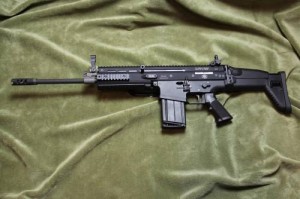 however; you are paying for one the best and most impressive large frame semi-automatic AR style rifles currently on the civilian market. The SCAR 17s is the civilian legal version the SCAR 17h, a rifle developed for military use chambered in 7.62×51 NATO/.308 WIN. The SCAR 17s is the big brother of the SCAR 16s, which is chambered in 5.56 NATO and was designed by FN Herstal to be a candidate to replace the M16 and M4 in military operations. The SCAR 17s is to the SCAR 16s what the AR-10 is to the AR-15; a larger frame version chambered in a larger caliber, but keeping the same basic parts, design, profile and functionality. The SCAR 17s is built on a gas piston operating system similar to the AK47, but unlike the AK platform it is fully ambidextrous with a modular design that is very easy to disassemble, clean, and reassemble. A true battle rifle, this weapon is capable of making the long shots that the smaller frame AR style rifles cannot, and penetrate cover that would stand in the way of the smaller caliber AR’s chambered in 5.56/.223. The stopping power of this rifle is outstanding, utilizing the large battle tested 7.62×51 NATO round that is big enough to stop just about anything that stands in its way. The SCAR 17s has a side-folding stock that is also telescopic and has a built-in adjustable cheek riser, making it extremely versatile and capable of both mid-range and long-range accuracy. Due to its advanced design, the SCAR 17s does not have the serious recoil you would expect from a .308. A lot of time and testing went into designing this rifle for military use, designed to replace the classic M1 in military and special law enforcement operations, and it is currently being integrated into military installations around the world. When it comes to a heavy hitting round like the .308, you won’t find a better semi-automatic military style rifle than the SCAR 17s.
however; you are paying for one the best and most impressive large frame semi-automatic AR style rifles currently on the civilian market. The SCAR 17s is the civilian legal version the SCAR 17h, a rifle developed for military use chambered in 7.62×51 NATO/.308 WIN. The SCAR 17s is the big brother of the SCAR 16s, which is chambered in 5.56 NATO and was designed by FN Herstal to be a candidate to replace the M16 and M4 in military operations. The SCAR 17s is to the SCAR 16s what the AR-10 is to the AR-15; a larger frame version chambered in a larger caliber, but keeping the same basic parts, design, profile and functionality. The SCAR 17s is built on a gas piston operating system similar to the AK47, but unlike the AK platform it is fully ambidextrous with a modular design that is very easy to disassemble, clean, and reassemble. A true battle rifle, this weapon is capable of making the long shots that the smaller frame AR style rifles cannot, and penetrate cover that would stand in the way of the smaller caliber AR’s chambered in 5.56/.223. The stopping power of this rifle is outstanding, utilizing the large battle tested 7.62×51 NATO round that is big enough to stop just about anything that stands in its way. The SCAR 17s has a side-folding stock that is also telescopic and has a built-in adjustable cheek riser, making it extremely versatile and capable of both mid-range and long-range accuracy. Due to its advanced design, the SCAR 17s does not have the serious recoil you would expect from a .308. A lot of time and testing went into designing this rifle for military use, designed to replace the classic M1 in military and special law enforcement operations, and it is currently being integrated into military installations around the world. When it comes to a heavy hitting round like the .308, you won’t find a better semi-automatic military style rifle than the SCAR 17s.
Pros:
The firepower of the SCAR 17s is unmatched when it comes to semi-automatic .308 caliber battle rifles, and drastic improvements have been made over the more traditional AR-10 or SR-25 chambered in the same caliber. The heavy hitting round offers great stopping power in a battle tested NATO round, which can take down anything from a deer to a bear in one shot. The SCAR 17s has very little recoil for a .308 and feels more like a 5.56 when shooting due to the advanced design. The low recoil combined with the advanced modular design of this rifle allows the shooter to be more accurate when firing multiple shots in rapid succession. Built-in flip-up back up sights provide a secondary mode of target acquisition should your optics fail during use. The folding stock offers versatility and maneuverability when moving through tight areas, and makes transportation easier as well.
Cons:
Although I am a huge fan of the SCAR 17s, it does have a few drawbacks. First off, it is a very expensive rifle. After tax, DROS and background check fees, you won’t get out of the shop with this rifle without dropping nearly $3,500 for a factory model with no upgrades or modifications. Especially considering the current political situation inflating costs, this is going to hit your wallet hard. Having said that, it is worth every dime in my opinion to have this rifle in your gun safe. Ammunition for this rifle is also going to be expensive and potentially more difficult to find compared to other calibers. Especially if you are looking for high quality factory loads like those offered by Barnes, you are going to be looking at about $2 per round right now depending on what state you live in. Because of the higher cost of the ammo, it may be a bit harder to come by in a SHTF situation. Low availability is another issue you will come across if you decide you want to purchase a SCAR 17s. They are one of the more difficult to find “assault rifles” due to high demand from both military and civilian purchasers alike, and because of that scarcity the price markup will be considerable. It is also a heavy weapon, especially when fully loaded with a 20 round magazine, so moving quickly with the rifle is not as easy as it would be with a lighter AR15 or AK47. One other drawback of the SCAR 17s is the proprietary FN magazines it uses, which cost about $100 each for a twenty round magazine. Unlike many other rifles including the AR15 and AK47, there are no aftermarket magazines available that fit the SCAR 17 mag well, so extra mags are expensive and difficult to find. I have heard that aftermarket magazines for the SCAR 17 are currently being developed, but as of now they are not yet available. One other thing to point out that some may consider to be a drawback is the reciprocating charging handle. Similar to the AK charging handle, the SCAR 17s charging handle reciprocates with each shot. This can add extra kick and make it slightly more difficult to maintain your aim the way you can with an AR15 which has a charging handle that does not reciprocate on one side of the firearm. It can also cause malfunctions if the shooters hand gets in the way while firing the weapon. There are varied opinions about this, some people like it and some hate it, and it’s really just a matter of personal preference.
Source: doomsdaymoose.com
OTHER USEFUL VIDEOS:
The 3 Pioneer Survival Lessons We Should Learn
The Most Effective Home Defense Strategies
Old School Hacks for Off-Grid Living
The Medical Emergency Crash Course
The Smart, Easy Way to Food Independence
How to Survive the Coming 100 Years Long Drought

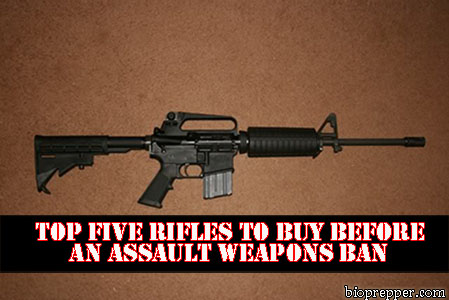


Not a bad effort, though a little more research on the comparative characteristics of the cartridges involved may have helped.
First of all, I would never consider a 10-22 a assault rifle! Assault is a action, not a type of weapon. These are sporting rifles (at least in the case of the AR-15 and the 10-22), not assault weapons. Just because they are used in battle situations does not make them assault rifles. When the peasants revolted against their evil land barons with shovels, hoes & rakes, were they wielding assault rakes? Come on, don’t perpetuate the hate!
Tell me more about the Saiga 12.
Price??
I will stick to the FAL and PTR91 both of which are battle proven 7.62×51’s.
They are cheaper and mags are not a problem. 1/3 of the price of the SCAR 17.
Definitely not the best SCAR to choose out of all of them, but honestly one not only with barrels for both the 556 and 762, but 2 of the entire different models, one of each, should be on this list. The best assault rifle since the M-16, it also has so many interchangeable and different parts and ways to customize and design a specific weapon and tons of combos for so many preferences, needs, etc.